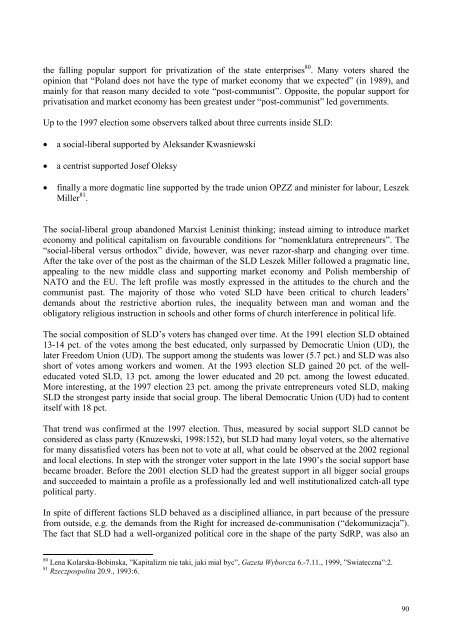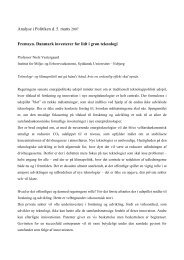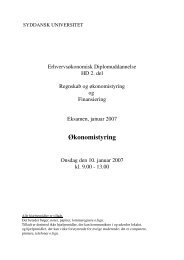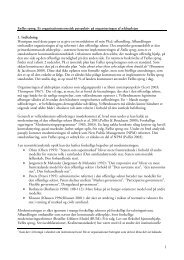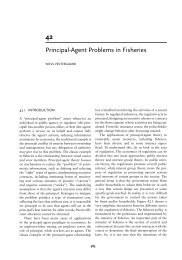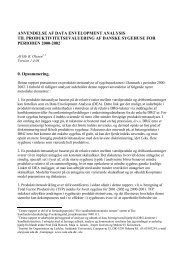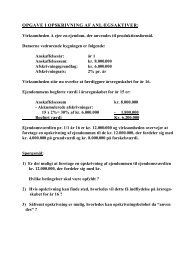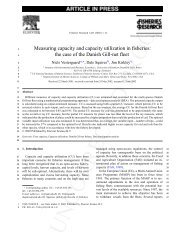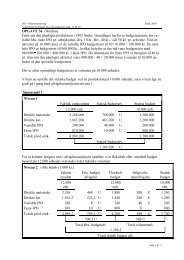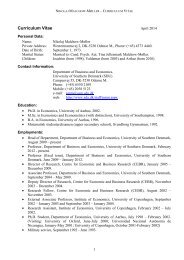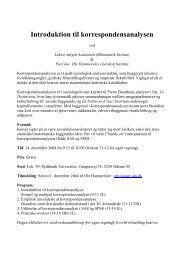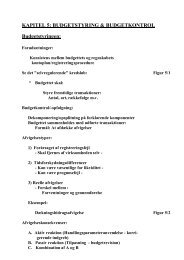Development of Parties and Party Systems in ... - lah@sam.sdu.dk
Development of Parties and Party Systems in ... - lah@sam.sdu.dk
Development of Parties and Party Systems in ... - lah@sam.sdu.dk
- No tags were found...
Create successful ePaper yourself
Turn your PDF publications into a flip-book with our unique Google optimized e-Paper software.
the fall<strong>in</strong>g popular support for privatization <strong>of</strong> the state enterprises 80 . Many voters shared theop<strong>in</strong>ion that “Pol<strong>and</strong> does not have the type <strong>of</strong> market economy that we expected” (<strong>in</strong> 1989), <strong>and</strong>ma<strong>in</strong>ly for that reason many decided to vote “post-communist”. Opposite, the popular support forprivatisation <strong>and</strong> market economy has been greatest under “post-communist” led governments.Up to the 1997 election some observers talked about three currents <strong>in</strong>side SLD:• a social-liberal supported by Aleks<strong>and</strong>er Kwasniewski• a centrist supported Josef Oleksy• f<strong>in</strong>ally a more dogmatic l<strong>in</strong>e supported by the trade union OPZZ <strong>and</strong> m<strong>in</strong>ister for labour, LeszekMiller 81 .The social-liberal group ab<strong>and</strong>oned Marxist Len<strong>in</strong>ist th<strong>in</strong>k<strong>in</strong>g; <strong>in</strong>stead aim<strong>in</strong>g to <strong>in</strong>troduce marketeconomy <strong>and</strong> political capitalism on favourable conditions for “nomenklatura entrepreneurs”. The“social-liberal versus orthodox” divide, however, was never razor-sharp <strong>and</strong> chang<strong>in</strong>g over time.After the take over <strong>of</strong> the post as the chairman <strong>of</strong> the SLD Leszek Miller followed a pragmatic l<strong>in</strong>e,appeal<strong>in</strong>g to the new middle class <strong>and</strong> support<strong>in</strong>g market economy <strong>and</strong> Polish membership <strong>of</strong>NATO <strong>and</strong> the EU. The left pr<strong>of</strong>ile was mostly expressed <strong>in</strong> the attitudes to the church <strong>and</strong> thecommunist past. The majority <strong>of</strong> those who voted SLD have been critical to church leaders’dem<strong>and</strong>s about the restrictive abortion rules, the <strong>in</strong>equality between man <strong>and</strong> woman <strong>and</strong> theobligatory religious <strong>in</strong>struction <strong>in</strong> schools <strong>and</strong> other forms <strong>of</strong> church <strong>in</strong>terference <strong>in</strong> political life.The social composition <strong>of</strong> SLD’s voters has changed over time. At the 1991 election SLD obta<strong>in</strong>ed13-14 pct. <strong>of</strong> the votes among the best educated, only surpassed by Democratic Union (UD), thelater Freedom Union (UD). The support among the students was lower (5.7 pct.) <strong>and</strong> SLD was alsoshort <strong>of</strong> votes among workers <strong>and</strong> women. At the 1993 election SLD ga<strong>in</strong>ed 20 pct. <strong>of</strong> the welleducatedvoted SLD, 13 pct. among the lower educated <strong>and</strong> 20 pct. among the lowest educated.More <strong>in</strong>terest<strong>in</strong>g, at the 1997 election 23 pct. among the private entrepreneurs voted SLD, mak<strong>in</strong>gSLD the strongest party <strong>in</strong>side that social group. The liberal Democratic Union (UD) had to contentitself with 18 pct.That trend was confirmed at the 1997 election. Thus, measured by social support SLD cannot beconsidered as class party (Knuzewski, 1998:152), but SLD had many loyal voters, so the alternativefor many dissatisfied voters has been not to vote at all, what could be observed at the 2002 regional<strong>and</strong> local elections. In step with the stronger voter support <strong>in</strong> the late 1990’s the social support basebecame broader. Before the 2001 election SLD had the greatest support <strong>in</strong> all bigger social groups<strong>and</strong> succeeded to ma<strong>in</strong>ta<strong>in</strong> a pr<strong>of</strong>ile as a pr<strong>of</strong>essionally led <strong>and</strong> well <strong>in</strong>stitutionalized catch-all typepolitical party.In spite <strong>of</strong> different factions SLD behaved as a discipl<strong>in</strong>ed alliance, <strong>in</strong> part because <strong>of</strong> the pressurefrom outside, e.g. the dem<strong>and</strong>s from the Right for <strong>in</strong>creased de-communisation (“dekomunizacja”).The fact that SLD had a well-organized political core <strong>in</strong> the shape <strong>of</strong> the party SdRP, was also an80 Lena Kolarska-Bob<strong>in</strong>ska, ”Kapitalizm nie taki, jaki mial byc”, Gazeta Wyborcza 6.-7.11., 1999, ”Swiateczna”:2.81 Rzeczpospolita 20.9., 1993:6.90


